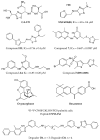Negative Immune Checkpoint Inhibitors
- PMID: 40574024
- PMCID: PMC12195700
- DOI: 10.3390/pharmaceutics17060713
Negative Immune Checkpoint Inhibitors
Abstract
Checkpoint inhibitors are a modern therapeutic approach for treating various types of cancer, metabolic diseases, and chronic infections. The main goal of this therapy is to specifically unlock the immune system, allowing it to recognize and eliminate cancer cells or pathogens, primarily through the activation of T lymphocytes. Monoclonal antibodies used in the treatment of various cancers, such as pembrolizumab (Keytruda), nivolumab (Opdivo), and ipilimumab (Yervoy), carry several limitations, primarily due to their large molecular size. The main challenges include limited tissue penetration, long half-life in the body, and the risk of autoimmune responses. Compared to antibodies, small-molecule and peptide inhibitors offer significant advantages related to their molecular structure. These drugs demonstrate a better ability to penetrate hard-to-reach areas, such as the tumor microenvironments, can be administered orally, and often show lower immunogenicity. A new generation of drugs is PROTACs, which combine the ability to direct proteins to degradation with the action of checkpoint inhibitors, contributing to the elimination of proteins responsible for suppressing the immune response. This publication describes small-molecule inhibitors, peptide inhibitors, and PROTAC molecules targeting negative immune checkpoints-CTLA-4, PD-1, VISTA, TIM-3, BTLA-4, LAG-3, and TIGIT.
Keywords: PROTAC; immune checkpoint; peptide inhibitors; small-molecule inhibitors.
Conflict of interest statement
The authors declare no conflicts of interest.
Figures











Similar articles
-
Nivolumab for adults with Hodgkin's lymphoma (a rapid review using the software RobotReviewer).Cochrane Database Syst Rev. 2018 Jul 12;7(7):CD012556. doi: 10.1002/14651858.CD012556.pub2. Cochrane Database Syst Rev. 2018. PMID: 30001476 Free PMC article.
-
Systemic pharmacological treatments for chronic plaque psoriasis: a network meta-analysis.Cochrane Database Syst Rev. 2021 Apr 19;4(4):CD011535. doi: 10.1002/14651858.CD011535.pub4. Cochrane Database Syst Rev. 2021. Update in: Cochrane Database Syst Rev. 2022 May 23;5:CD011535. doi: 10.1002/14651858.CD011535.pub5. PMID: 33871055 Free PMC article. Updated.
-
A rapid and systematic review of the clinical effectiveness and cost-effectiveness of paclitaxel, docetaxel, gemcitabine and vinorelbine in non-small-cell lung cancer.Health Technol Assess. 2001;5(32):1-195. doi: 10.3310/hta5320. Health Technol Assess. 2001. PMID: 12065068
-
Lenvatinib plus pembrolizumab for untreated advanced renal cell carcinoma: a systematic review and cost-effectiveness analysis.Health Technol Assess. 2024 Aug;28(49):1-190. doi: 10.3310/TRRM4238. Health Technol Assess. 2024. PMID: 39252678 Free PMC article.
-
First-line therapy for adults with advanced renal cell carcinoma: a systematic review and network meta-analysis.Cochrane Database Syst Rev. 2023 May 4;5(5):CD013798. doi: 10.1002/14651858.CD013798.pub2. Cochrane Database Syst Rev. 2023. PMID: 37146227 Free PMC article.
References
Publication types
Grants and funding
LinkOut - more resources
Full Text Sources
Research Materials

